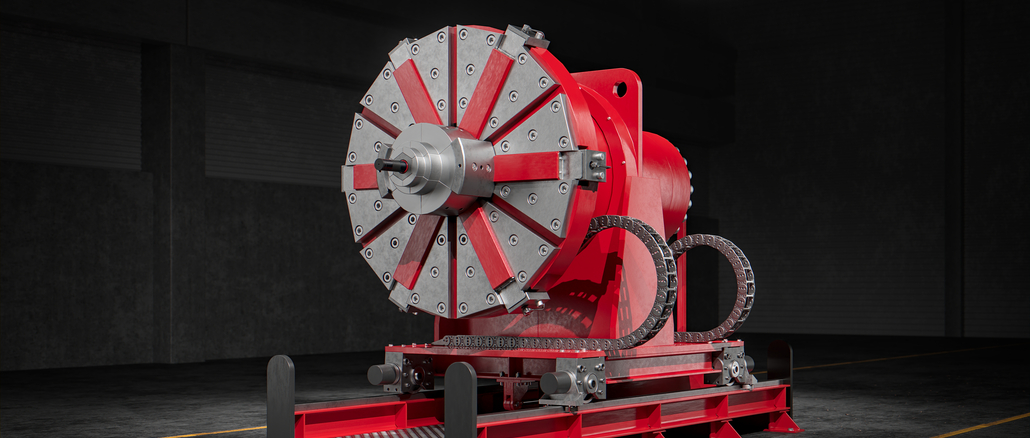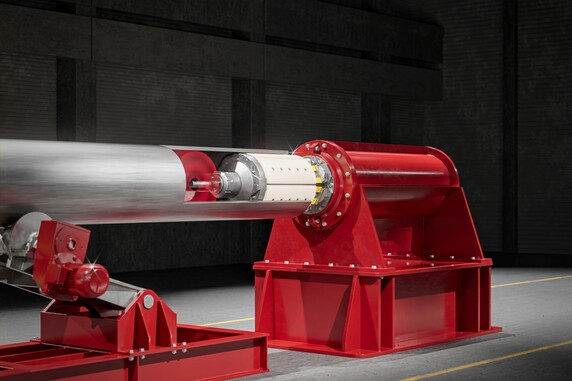
At TUBE, Dango & Dienenthal (D&D) will present laser-based calibration of large-diameter pipes for the first time. According to the manufacturer, the PST series machines achieve unprecedented precision. At the same time, they drastically reduce the time required for straightening and enable seamless documentation of the inner contour.

© Dango & Dienenthal Mechanical Engineering
The fundamental new feature of Pipe Sizing Technology (PST) is that a 360° circular laser measures the inner contour of the pipe during the straightening process and the results are immediately incorporated into the process. The PST series machines are generally used for straightening. The PST-PE-EX version is additionally suitable for expanding the pipe ends, the PST-FB version (full body sizing) straightens the pipes over their entire length.
The laser mounted in the measuring head projects a line onto the inner wall of the pipe. A camera, which is also located in the measuring head, records up to 3,200 measuring points on the circular line over the entire circumference of the pipe. In this way, the complete image of the inner contour of the pipe is created in real time. These data are the basis for controlling the straightening tools.
For “sizing”, the PST-PE machines have six spreading jaws, which – according to the results of the laser measurement – are specifically controlled. The result: the tube is not expanded, but retains the original inner circumference.
More accurate and faster
Since measuring and forming are combined in the Pipe Sizer, the systems drastically reduce the time required for handling the pipes. This means that considerably more tubes can be straightened per shift than was usual with conventional systems. For example, laser contour measurement makes it possible for the first time to measure each individual tube with little time and to document the geometry – for example, inner circumference and ovality.
The first PST-PE-EX machine currently being manufactured by D&D for a German manufacturer of large-diameter pipes will straighten and expand the ends of pipes with diameters between 270 and 1,016 mm with wall thicknesses up to 60 mm. Here, too, the circular laser provides the inner contour of the tube end, which is used to control the pressure cylinder.
Denis Albayrak, Senior Sales Engineer at D&D, relies on precise laser measurement: “The demands on the quality of pipes – especially on their optimum roundness – have grown steadily in recent years and present pipe manufacturers with enormous challenges. With Pipe Sizing Technology, we replace ‘trial and error’ with exact measured values. The finished pipes have the perfect circular shape after sizing, and the specified nominal diameter remains unchanged.”
The technology in detail

© Dango & Dienenthal Mechanical Engineering
The measuring system mounted on the face of the Pipe Sizer works according to the laser triangulation principle: a circular laser projects a line over the entire inner circumference of the pipe. A camera captures the line with 3,200 points distributed around the circumference of the pipe, which corresponds to an angular resolution of around 0.17 degrees. For pipe diameters up to 1,600 mm (64 in.), the resolution of the contour measurement is 0.1 mm; for systems for nominal diameters up to 1,000 mm, it is 0.05 mm.
From the results, the software calculates the default values for the spreading jaws and transmits them to the process control. When sizing with the PST-PE and PST-FB versions, the six spreader segments distributed around the circumference of the pipe are individually controlled by hydraulic cylinders depending on the geometry of the pipe.
Once the first sizing process is complete, the pipe is measured again. With this contour data, the software determines the springback value of the tube material and calculates it into the second sizing process. In this way, the individual material properties of each tube are used for targeted sizing.
